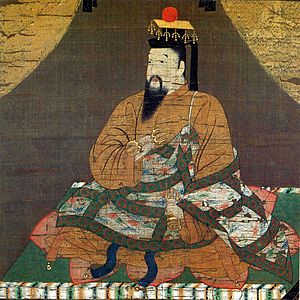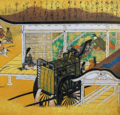Emperor Go-Daigo facts for kids
Quick facts for kids Emperor Go-Daigo後醍醐天皇 |
|||||
|---|---|---|---|---|---|
 |
|||||
| Emperor of Japan | |||||
| Reign | 29 March 1318 – 18 September 1339 | ||||
| Coronation | 30 April 1318 | ||||
| Predecessor | Hanazono | ||||
| Successor | Go-Murakami Kōgon (Pretender) |
||||
| Shōgun | Prince Morikuni Prince Moriyoshi Prince Narinaga Ashikaga Takauji |
||||
| Born | 26 November 1288 Heian-kyō, Kamakura shogunate |
||||
| Died | 19 September 1339 (aged 50) Yoshino no Angū (Nara), Ashikaga shogunate |
||||
| Burial | Tō-no-o no misasagi (塔尾陵) (Nara) | ||||
| Spouse | Saionji Kishi Junshi |
||||
| Issue Among others... |
|
||||
|
|||||
| House | Yamato | ||||
| Father | Emperor Go-Uda | ||||
| Mother | Fujiwara no Chūshi | ||||
| Signature | |||||
Emperor Go-Daigo (後醍醐天皇 Go-Daigo-tennō) (born 26 November 1288 – died 19 September 1339) was the 96th emperor of Japan. He is famous for trying to bring back the emperor's power in Japan. He successfully ended the rule of the Kamakura shogunate in 1333.
He then started the Kenmu Restoration, which was a short period where the emperor had real power. This was the last time an emperor had such direct control until the Meiji Restoration in 1868. However, his restoration was overthrown by Ashikaga Takauji in 1336. This led to the start of the Ashikaga shogunate. It also split the imperial family into two groups: the Northern Court in Kyoto and the Southern Court in Yoshino. Go-Daigo led the Southern Court.
He chose his own posthumous name (a name given after death). He picked it after the 9th-century Emperor Daigo. The "go-" (後) means "later," so he is sometimes called "Later Emperor Daigo."
Contents
Go-Daigo's Early Life
Before he became emperor, his personal name was Takaharu-shinnō. He was the second son of Emperor Go-Uda. His mother was Fujiwara no Chūshi.
Emperor Go-Daigo dreamed of a time when the emperor ruled directly, like during the Engi era (901–923) under Emperor Daigo. This is why he chose to share his name with Emperor Daigo.
Key Events in Go-Daigo's Reign
- 1308: When Emperor Go-Nijō died, Emperor Hanazono became emperor. Takaharu-shinnō (Go-Daigo) was chosen as the Crown Prince. This was decided by the Kamakura shogunate, which was the military government at the time.
- 1318: Emperor Hanazono stepped down. Takaharu-shinnō became Emperor Go-Daigo.
- 1324: Emperor Go-Daigo started planning to overthrow the Kamakura shogunate. His plans were discovered, and one of his close friends, Hino Suketomo, was removed from his position. This event is known as the Shōchū Incident.
- 1331: Go-Daigo's plans were found out again during the Genkō Incident. He tried to hide the Japanese imperial regalia (important treasures) in a castle. He also gathered an army. However, the shogunate's army captured the castle. They then put Emperor Kōgon on the throne. Go-Daigo was sent away to Oki Province, a group of islands.
- 1333: Emperor Go-Daigo managed to escape from Oki with help from Nawa Nagatoshi. He gathered another army. Ashikaga Takauji, a general sent by the shogunate to fight Go-Daigo, instead joined forces with the emperor. Takauji captured the shogunate's office in Kyoto. At the same time, Nitta Yoshisada attacked Kamakura, the shogunate's main city. When Kamakura fell, the Hōjō family, who were the shogunate's leaders, died. This ended the Kamakura shogunate's power.
- The Kenmu Restoration: Go-Daigo returned to Kyoto and took back the throne from Emperor Kōgon. He began the Kenmu Restoration. He wanted to rule Japan directly, like the emperors of China. However, his quick changes and decisions caused problems. Many people, especially the samurai, were unhappy.
- 1335: Ashikaga Takauji became unhappy with Go-Daigo's rule. Go-Daigo ordered Nitta Yoshisada to defeat Takauji. Takauji won some battles, but then Kusunoki Masashige and Kitabatake Akiie defeated Takauji's army. Takauji fled to Kyūshū.
- 1336: Takauji gathered a new army and returned to Kyoto. Kusunoki Masashige suggested that Go-Daigo make peace with Takauji, but Go-Daigo refused. He ordered Masashige and Yoshisada to fight Takauji. Kusunoki's army was defeated at the Battle of Minatogawa.
- The Split of the Imperial Court: When Takauji's army entered Kyoto, Emperor Go-Daigo escaped to Mount Hiei. He sent the imperial regalia to Takauji, but it was a fake set. Takauji then put Emperor Kōmyō on the throne and officially started his own military government, the Ashikaga shogunate.
- 1337: Go-Daigo escaped from Kyoto. He set up his own court in the mountains of Yoshino. This began the Nanboku-chō period, also known as the Period of Northern and Southern Courts. There was a Northern Court in Kyoto and Go-Daigo's Southern Court in Yoshino. Go-Daigo sent his sons to different parts of Japan to fight against the Northern Court.
- 1339: Go-Daigo stepped down as emperor in Yoshino. His son, Noriyoshi-shinnō, became Emperor Go-Murakami. Go-Daigo died the next day.
His grave is in Nara and is called Tō-no-o no misasagi. There is also a memorial Shinto shrine honoring him.
Family of Emperor Go-Daigo
Emperor Go-Daigo had many children. Here are some of his important family members:
- Empress (Chūgū): Saionji Kishi
- Imperial Princess Kanshi (1315–1362): She later married Emperor Kōgon.
- Empress (Chūgū): Imperial Princess Junshi
- Court lady: Fujiwara (Ano) no Renshi (1301–1359)
- Imperial Prince Tsunenaga
- Imperial Prince Nariyoshi
- Imperial Prince Noriyoshi: He later became Emperor Go-Murakami.
- Court lady: Minamoto no Chikako
- Imperial Prince Moriyoshi
- Court lady: Fujiwara no Ishi/Tameko
- Imperial Prince Takanaga
- Imperial Prince Munenaga
- Court lady: Fujiwara (Nijo) Michiko (died 1351)
- Prince Kaneyoshi (1326–1383)
Eras During Go-Daigo's Reign
In Japan, periods of time are often named after the emperor's reign. These are called nengō or era names. Emperor Go-Daigo's reign had many era names.
- Before the Northern and Southern Courts split:
- Bunpō (1317–1319)
- Gen'ō (1319–1321)
- Genkō (1321–1324)
- Shōchū (1324–1326)
- Karyaku (1326–1329)
- Gentoku (1329–1331)
- Genkō (1331–1334)
- Kenmu (1334–1336)
- During the Southern Court (Go-Daigo's court):
- Engen (1336–1340)
- During the Northern Court (the rival court):
Images for kids
See also
 In Spanish: Go-Daigo Tennō para niños
In Spanish: Go-Daigo Tennō para niños




